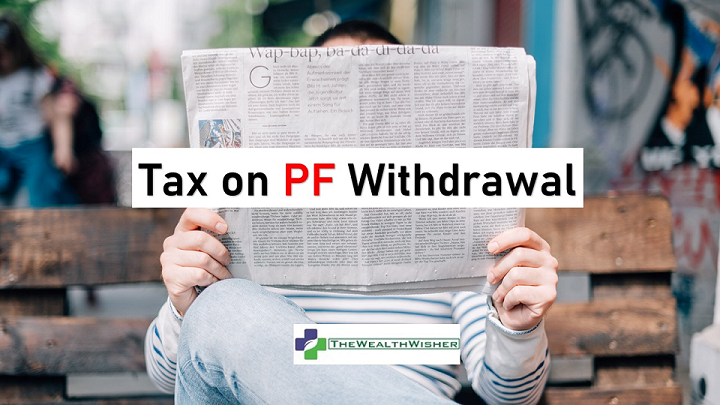EPF or employee Provident Fund is hard-earned money through your service to an organization. Overall if a person is attaining superannuation, it is supposed to be tax-free. BUT NOT ALWAYS! Money received from EPF can be taxable or there can be tax deducted at source (TDS). Let us understand Taxation on PF Withdrawal or Taxation on EPF Withdrawal – as it is called since the fund is managed by Employee Provident Fund Organisation (EPFO).
The word PF & EPF are used interchangeably. Taxation on EPF Withdrawal rule remain same for PF & EPF.
EPF Benefit
EPF is a retirement oriented scheme, where your employer deducts a percentage from your earnings. The same amount is contributed by the employer. So money doubles up and is invested for you in a fund. This fund can be central EPFO (Employee Provident Fund Organization) or State EPFO or a privately managed fund by your employee for eg railways or ONGC etc.
EPF contribution gets defined returns. This means it works like an FD. It also gives you tax benefit in the year of contribution up to INR 1.5 Lakhs.
Taxation on PF Withdrawal
When you attain superannuation at the age of 55 or more, you may withdraw the entire balance (your contribution + Employer contribution + interest). The entire amount is tax-free as a retiral benefit.
But there is some catch….
In today’s world of competition, not all work for governments. Many employees change jobs including government employees. So one has to change his EPF account & trust managing it.
Sometimes people start on their own (like me!). Salaried turned Entrepreneurs have to withdraw EPF money for their usage as well as there is no contribution to the EPF account. It becomes dormant & finally inactive.
You can withdraw PF for some life events like further studies or while buying home or funding treatment of yourself or family members. Details Here
What is the Taxation on PF Withdrawal in those scenarios? Let’s check:
- If EPF is withdrawn after 5 Years of continuous service.
Here the word “continues” is important. It means, you can have any number of employers but service has to be non-interruptive. You should withdraw PF in between and transfer when there is change in job.
In this case, the entire balance is Tax-Free. There will be no TDS also.
- PF balance is transferred from one employer to another due to change in the company.
In this case, no TS will apply. Also, the entire money is taxfree. You would not get anything in hand. So no taxability arises.
- What if the company closes and employee is forced to withdraw money (Before 5 Years)?
Since it is not in control of employee there will be no TDS and No Tax on PF Withdrawal.
- The employee is facing ill health, and he has no desire to continue in the workforce (Before 5 Years)?
Health issues are treated on empathy grounds hence no TDS and no Tax on PF Withdrawal.
- If EPF is withdrawn before 5 years of continuous service.
The employer’s contribution to EPF as well as the interest earned is added to the income of the employee. He has to pay tax as per his slab. Only self contribution is taxfree. Also, the rules for TDS differ as per the amount of withdrawal. If
- The amount is less than Rs 50000, no TDS is applicable.
- Amount exceeds Rs 50000/- TDS at the rate of 10% to be deducted.
One can provide Form 15 G or 15 H (age above 60 Years) to stop the TDS.
-
The EPF contributions stop, but the employee does not withdraw.
Sometimes employee leaves the amount in EPF so that they can earn interest on it.
BUT EPF is not an investment scheme. So the rules are:
- The account becomes inoperative if 3 contributions are not received. This means it will keep on earning interest until it becomes active again or inactive completely.
- If the account is inactive, the holder will not get any interest after he/she attains the age of 58. The account becomes dormant at age 58.
- The amount of interest from the date of resignation becomes taxable.
Let’s us take an example to understand this:
Anu age 34, worked for 20 years, and resigned on Jan 1, 2015, and went to US. Her balance at that time was Rs 1200000. So in her absence, the account kept earning interest, and balance was Rs 1500000 on 31 March 2020. (I am not taking exact interest as per rate to avoid calculation contusion. Just taking round figures for ease.)
She was out of the country, so the account becomes inoperative as no new contribution was received after Jan 2018. Now she comes back in April 2020 and withdraws the balance.
Her balance is Rs 1500000. Out of which Rs 1200000 is tax-free. Rs 300000 is added to her income of FY 2020-21.
Any questions on Taxation on PF Withdrawal ?
Please email me on madhupam at thewealthwisher dot com or do let me know what you think in the comments section below.









